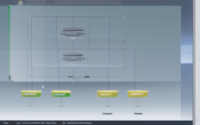Advancing Lunar Exploration with Modular Spacecraft
Advancing Lunar Exploration with Modular Spacecraft
Introduction to Modular Spacecraft:
Modular spacecraft are a pivotal advancement in space exploration technology. These spacecraft are designed with interchangeable and customizable components, allowing for more flexibility and adaptability in mission planning and execution. They are especially crucial for lunar exploration missions due to the unique challenges presented by the lunar environment. By utilizing modular spacecraft, space agencies and private companies can enhance the efficiency and versatility of their missions to the moon.
Benefits of Modular Spacecraft for Lunar Exploration:
1. Flexibility: Modular spacecraft can be configured in various ways to suit different mission objectives. Components such as propulsion systems, scientific instruments, and communication devices can be easily swapped out or upgraded, allowing for rapid adaptation to changing mission requirements.
2. Cost-Effectiveness: The modular design of spacecraft reduces the need for building entirely new spacecraft for each mission. Instead, existing components can be repurposed and combined in different configurations, leading to cost savings.
3. Scalability: Modular spacecraft enable gradual expansion of capabilities over time. New modules can be added to existing spacecraft to enhance functionality and performance, making them ideal for long-term lunar exploration missions.
4. Redundancy: By incorporating redundant modules, modular spacecraft can mitigate the risk of component failures. If one module malfunctions, others can take over its functions, increasing the overall reliability of the spacecraft.
Key Components of Modular Spacecraft:
1. Core Module: The central structure that houses essential systems such as power generation, thermal control, and guidance.
2. Payload Module: Contains specialized equipment for conducting scientific experiments, capturing images, or analyzing lunar samples.
3. Propulsion Module: Provides the spacecraft with the ability to maneuver in space and perform trajectory adjustments.
4. Communication Module: Facilitates data transmission between the spacecraft and mission control on Earth.
5. Resource Module: Stores consumables such as water, oxygen, and fuel to sustain crew members or robotic missions.
Design Considerations for Modular Lunar Spacecraft:
1. Interoperability: Standardized interfaces and connectors are crucial to ensure seamless integration of modules from different manufacturers.
2. In-Situ Resource Utilization: Incorporating systems that can utilize lunar resources such as water ice or regolith for fuel production can enhance the sustainability of lunar missions.
3. Radiation Protection: Lunar missions face exposure to high levels of radiation, requiring spacecraft designs that incorporate effective shielding to protect crew members and sensitive equipment.
4. Reusability: Designing modules that can be reused across multiple missions reduces overall costs and accelerates mission planning timelines.
Case Study: Artemis Program:
The Artemis program led by NASA exemplifies the use of modular spacecraft for lunar exploration. NASA’s Gateway, a lunar outpost that will orbit the moon, is being constructed using a modular approach. Different components of the Gateway, such as habitat modules, airlocks, and scientific laboratories, are being developed as standalone units that can be assembled in space. This modular construction method allows for phased deployment of the Gateway and enables future expansion as more modules are added to the outpost.
Future Outlook for Modular Lunar Spacecraft:
As technology advances and the commercial space industry grows, the utilization of modular spacecraft for lunar exploration is expected to become more prevalent. With the advent of 3D printing technology and in-space manufacturing capabilities, the customization and rapid prototyping of modular spacecraft components will become increasingly feasible. This trend will ultimately lead to more cost-effective, efficient, and sustainable methods for exploring the moon and beyond.

